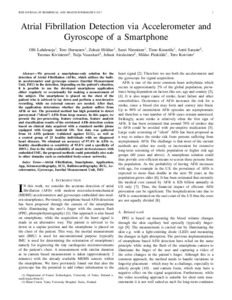Atrial Fibrillation Detection via Accelerometer and Gyroscope of a Smartphone
Olli Lahdenoja; Tero Hurnanen; Zuhair Iftikhar; Sami Nieminen; Timo Knuutila; Antti Saraste; Tuomas Kiviniemi; Tuija Vasankari; Juhani Airaksinen; Mikko Pänkäälä; Tero Koivisto
https://urn.fi/URN:NBN:fi-fe2021042717491
Tiivistelmä
Atrial Fibrillation (AFib), which utilizes the built-in accelerometer and gyroscope sensors (Inertial Measurement Unit, IMU) in the detection. Depending on the patient’s situation,it is possible to use the developed smartphone application either regularly or occasionally for making a measurement of the subject. The smartphone is placed on the chest of the patient who is adviced to lay down and perform a non-invasive recording, while no external sensors are needed. After that, the application determines whether the patient suffers from AFib or not. The presented method has high potential to detect paroxysmal (”silent”) AFib from large masses. In this paper, we present the pre-processing, feature extraction, feature analysis and classification results of the envisioned AFib detection system based on clinical data acquired with a standard mobile phone equipped with Google Android OS. Test data was gathered from 16 AFib patients (validated against ECG), as well as a control group of 23 healthy individuals with no diagnosed heart diseases. We obtained an accuracy of 97.4% in AFib vs. healthy classification (a sensitivity of 93.8% and a specificity of 100%). Due to the wide availability of smart devices/sensors with embedded IMU, the proposed methods could potentially also scale to other domains such as embedded body-sensor networks.
Kokoelmat
- Rinnakkaistallenteet [27094]
